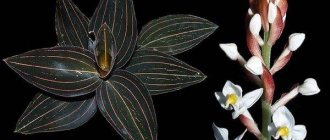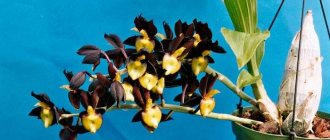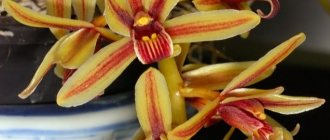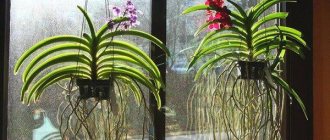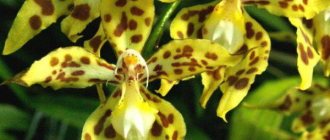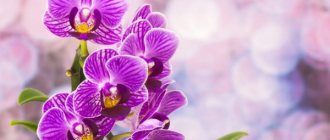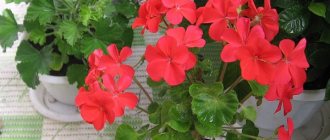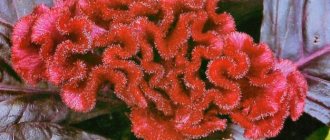| Orchid Medusa | |
| Scientific classification | |
| Kingdom: | Plantae |
| Clade : | Tracheophytes |
| Clade : | Angiosperms |
| Clade : | Monocots |
| Order: | Asparagus |
| Family: | Orchids |
| Subfamily: | Epidendroids |
| Tribe: | Dendrobieae |
| Genus: | Bulbophyllum |
| Variety: | B. medusae |
| Binomial name | |
| Bulbophyllum medusae (Lindl.)[1] | |
| Synonyms[1] | |
| |
Bulbophyllum medusae
, commonly known as
the Medusa Orchid
, is a species of epiphytic orchid with a creeping rhizome and a single leaf about 100 mm (3.9 in) long emerging from the top of each pseudobulb. The flowers are creamy yellow, collected in groups of fifteen, arranged in a circle at the end of the flowering stem. The flowers have an unpleasant smell. The flowers have thread-like lateral sepals about 120 mm (4.7 in) long, giving each cluster a Medusa-like appearance.[2]
The Medusa orchid was first officially described in 1861 by John Lindley who gave it the name Cirrhopetalum medusae
and published a description in
Edwards's Botanical Register
.[3][4] In 1861, Heinrich Gustav Reichenbach changed the name to
Bulbophyllum medusae
.[1]
Bulbophyllum medusae
grows on the trunk and main branches of trees in forests at altitudes up to 400 m (1,300 ft) in Thailand, Malaysia, Borneo, the Lesser Sunda Islands and Sumatra.[2]
Appearance
This exotic plant is a plant with waxy flowers up to 10 cm long. The inflorescences are presented in a wide variety of colors - green, yellow, red, pink, white. In this case, various inclusions on the petals are acceptable.
The flowers are attached to peduncles 12 cm long. The shape of the inflorescences is usually racemose, and the inflorescences themselves consist of multiple or single flowers . The lip of the bud can be simple or divided into parts. Bulbophyllum leaves are oval, leathery, reaching 20 cm in length.
The shape and thickness of the leaves are varied. The leaves are attached to the top of the pseudobulb (the thickened near-earth part of the stem in which the orchid accumulates moisture). Each type of Bulbophyllum has a different smell - from pleasant to repulsive.
The Bulbophyllum orchid is native to the subtropical and tropical forests of Africa, Asia, the southern, central and northern regions of America and New Guinea. This type of orchid was first mentioned by the botanist Louis Marie Aubert Du Petit-Thouard in his book “The History of Special Orchid Plants Collected on the French Islands of Southern Africa: Bourbon and Madagascar.”
Description
The genus Bulbophyllum from the Orchidaceae family includes almost 2000 species.
The tropics and subtropics of the whole world have become the natural habitat of these orchids. Representatives of the genus are so different from each other that finding “family traits” is sometimes very difficult. Suffice it to mention that the smallest orchid in the world (Bulbophyllum minutissimum) is the same full member of the genus as plants of impressive dimensions.
The sizes and shapes of pseudobulbs and leaves differ. Flowering begins at different times and lasts from several days to months. Peduncles grow both from the base of the pseudobulb and from the rhizome. There are species with a single bud and panicle inflorescences.
Flowers come in tiny and large, in all different shades. The surfaces of the flower elements can be uniformly colored or covered with intricate designs. The sepals, sometimes fused, are usually larger than the petals. The small swaying lip is hairy or ciliated. All Bulbophyllums smell. But since odors are designed for the preferences of insects, the definition of “fragrant” does not apply to all aromas.
Bulbophyllums easily adapt to living indoors, do not require much effort from the owner and often become a true decoration of a flower collection.
Subsorts with photos
It is impossible to mention all subvarieties of Bulbophyllum due to their large number; we will focus on the most basic ones.
Phalaenopsis
An orchid with leaves up to 120 cm long, with round pseudobulbs, with elongated flowers collected in a raceme . Many people note the unpleasant odor of this subvariety. Bulbophyllum phalaenopsis is native to Western New Guinea.
Echinolabium
Orchid with pink or red petals. The length of the peduncle is 70 centimeters, on which the buds are attached. The homeland of Bulbophyllum echinolabium is Indonesia.
Jellyfish
Exotic with dense dark green leaves . More than ten buds are attached to a long peduncle. Their flowering buds are similar to jellyfish, which gives the variety its name. The petals are white with orange or red splashes.
Lobba
This is a medium-sized orchid up to 30 cm long. On the peduncle there is only one flower with a diameter of 7 - 10 centimeters. At the same time, the length of the peduncle reaches 10 cm. The flower has a yellow-orange color with purple specks and stripes. The homeland of Bulbophyllum Lobba is Thailand, India and Burma.
Bloom
The flowering time of Bulbophyllum depends on its species . Mostly orchids of this type bloom in summer, but some varieties can delight you with their flowering in late autumn or winter. Flowering also depends on the variety - sometimes it is small, and sometimes the orchid has only one bud.
Care before and after
Before flowering - as a rule, this is spring and early summer - Bulbophyllum needs to be fed with complex mineral fertilizers for orchids. The frequency of feeding is once every 2 weeks. After flowering, the peduncle is removed, and if necessary, the exotic plant is replanted. When replanting, special attention should be paid to the roots, preventing them from being damaged or rotting. After transplantation, it is not recommended to water the exotic plant for some time.
Important! After flowering, the exotic plant begins a period of rest, and it needs to be moved to a cool place at a temperature of 12-15 ° C.
What to do if it doesn't bloom?
If an orchid does not bloom, it means that the conditions under which it is kept do not meet the required conditions and the life cycle of the plant is disrupted. Pay attention to the watering regime, substrate moisture and the condition of the plant roots. The temperature regime is also important; the plant probably does not bloom due to overheating. Perhaps the orchid does not have enough strength to bloom and needs feeding.
First steps after purchase
When transporting Bulbophyllum, the plant must be protected from precipitation, overheating and hypothermia. But the most important attention should be paid to the root system in order to prevent damage.
Blooming Bulbophyllum should not be disturbed. In any other condition, it is better to replant it immediately, after first inspecting the condition of the roots. If the owner prefers pot growing, then you need to choose a shallow and wide container with numerous holes in the bottom and walls. The substrate is placed on top and occupies no more than a quarter of the total volume of the pot; the rest of the space goes to the drainage layer.
Small pests rarely attack the plant, but snails simply prey on these orchids. Careful inspection and quarantine will help detect uninvited guests.
Growing
Choosing a location . It is best to place it on a windowsill facing south. Exotic must be protected from drafts and hypothermia. This variety is preferable to grow in hanging baskets and elongated pots. Miniature varieties of Bulbophyllum can be kept in special wet terrariums.- Preparing the soil and pot . Bulbophyllum can be grown with or without substrate. A wooden or clay pot is suitable for growing. The substrate must be breathable. A mixture of conifer bark with charcoal and sphagnum moss is ideal. When growing Bulbophyllum without a substrate (on blocks), it is recommended to make a small layer of moss between the plant and the block. This will prevent the roots from drying out.
- Temperature . Bulbophyllum loves high air temperatures (15°C and above in winter, and 25-30°C in summer).
- Humidity . The ideal humidity for this variety is 50% or higher, since dry air has a detrimental effect on the roots of the plant. To increase the humidity level, you need to place a tray with water. You can also use a household humidifier.
- Lighting . Bulbophyllum, as a light-loving plant, needs bright lighting, but in summer it needs slight shading from direct sunlight (for example, with a curtain) and fresh air.
- Watering . It is recommended to water the orchid abundantly in the summer; in winter, the frequency should be reduced. For irrigation, it is preferable to use warm distilled or purified water. Before watering, you need to make sure that the substrate is dry, but it should not be completely dry.
- Feeding . Exotic plants need to be fed once every two weeks with special mineral fertilizers dissolved in plenty of water. It is important to ensure that the orchid does not have an excess of nitrogen.
- Transfer. Transplantation should be done as needed, ideally once every 5-6 years.
- It is necessary to remove the orchid from the pot and inspect the soil to see if it is suitable for reuse. If necessary, a new pot should be taken larger if the orchid has grown.
- The root system must be thoroughly cleaned, removing all damaged parts.
- Place a layer of drainage at the bottom of the pot and fill the pot with substrate.
- The substrate can be bought ready-made or made yourself from a mixture of pine bark, sphagnum moss, rotted leaves and river sand (ratio 1:1:1:1). The bulbophyllum rhizome is fixed in the pot with a special device for fixing it.
Caring for bulbophyllum at home
Bulbophyllum frosty at home photo
How to water
Watering must be balanced, without overwatering or drying out the substrate. At the end of the growing season we gradually reduce it, and with the end of the formation of pseudobulbs we reduce it to a minimum, this also activates flowering. Watering can be done by immersing it in water or simply pouring it into the pot, but do not wet the pseudobulbs.
Air humidity
This orchid prefers an average level of air humidity. Periodically spray the space around the bulbophyllum with a fine spray; the droplets should not fall on the leaves and flowers.
Water for irrigation requires softened water: melted water, rain water, filtered water, or settled for 1-2 days.
How to feed and prune
Feeding the flower is required only during the growing season. Be sure to use special formulations for orchids, making the concentration half as much as recommended by the manufacturer. When applying fertilizers, follow the instructions.
While the peduncle is green, you cannot cut it, because it can still produce buds. Wait for it to dry completely.
Reproduction
As a rule, exotic plants are propagated by dividing the bush..
- To do this, the plant is removed from the pot, the rhizome is cleared of the substrate and divided into several parts, and each part should contain two or more pseudobulbs.
- The cut is processed with charcoal.
- Then each part is planted separately.
Reference! An orchid is considered rooted after the appearance of young shoots. More rare methods of propagation of Bulbophyllum are bulbs and seeds.
We invite you to watch a video about propagating an orchid by dividing a bush:
Diseases and pests
- Sometimes spotting may appear on the leaves of the orchid. This indicates that the plant lacks shade.
- Also, with excessive lighting, the color of the leaves may change.
- Rotting pseudobulbs indicate that the plant is being flooded or the soil moisture is too high.
- Pest control such as spider mites and aphids is also important. The mite can be found on the back of the leaf with white dots and almost transparent cobwebs. Aphids attack the stems of exotic plants. To destroy pests, they are washed off and the plant is treated with a soap solution. It is prepared as follows: dilute 30 grams of laundry soap in a liter of water, add 2-3 ml of the Actellik preparation to the solution.
Bulbophyllums are known for their diversity, and among them you will definitely find one that you like. And following our recommendations will keep the plant healthy and enjoy its flowering .
More than 150,000 varieties and hybrids of orchids are known to science. You can learn about the best of them - Cymbidium, Miltonia, Cambria, Beauty, Manhattan, Multiflora, Paphiopedilum, Ludisia, Zygopetalum and Philadelphia - from our articles.
